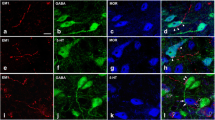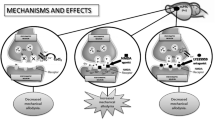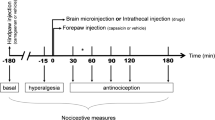Abstract.
The formalin test was used to investigate the interactive role of periaqueductal grey (PAG) N-methyl-D-aspartate (NMDA) and metabotropic glutamate (mGlu) receptors in the modulation of persistent noxious stimulation in mice. Intra-PAG microinjections of 1 or 3 nmol NMDA, a selective agonist at NMDA-subtype receptors, decreased the nociceptive response (–94±5% with 3 nmol) during the latter phase of the test. This effect was antagonized by MK-801, a selective antagonist at NMDA receptors. No change in the early nociceptive phase was observed after NMDA injection. Pretreatment either with 2-methyl-6-phenylethynylpyridine (MPEP, 25 nmol/mouse), a selective antagonist at mGlu5 receptors, or with (2S)-α-ethylglutamic acid [(2S)-α-EGlu, 30 nmol/mouse], a selective antagonist at group-II mGluRs, prevented the NMDA-induced antinociceptive effect during the late hyperalgesic phase. Pretreatment with (R,S)-α-methylserine-O-phosphate [(R,S)-α-MSOP, 70 nmol/mouse], a selective antagonist at group-III mGlu receptors, had no effect on the NMDA-induced antinociception. None of the antagonists changed the formalin-induced nociceptive behaviour per se with the dosages used in combination with NMDA. MPEP at 50 nmol/mouse, however, potentiated the early nociceptive phase whilst 100 nmol/mouse attenuated the late phase. Similarly, at the higher dose of 140 nmol/mouse, (R,S)-α-MSOP decreased the late hyperalgesic phase. These results provide additional evidence that NMDA and mGlu receptors participate in modulating the hyperalgesia induced by peripheral noxious stimulation. In particular, mGlu receptors may modulate the NMDA receptors in the PAG since their physiological stimulation seems to be required for the NMDA-induced effect. This suggests that, together with ionotropic glutamate receptors, mGlu receptors also play a role in modulating a type of spinal cord neuroplasticity (i.e. wind-up) that has been proposed to mediate hyperalgesia.
Similar content being viewed by others
Author information
Authors and Affiliations
Additional information
Electronic Publication
Rights and permissions
About this article
Cite this article
Berrino, .L., Oliva, .P., Rossi, .F. et al. Interaction between metabotropic and NMDA glutamate receptors in the periaqueductal grey pain modulatory system. Naunyn-Schmied Arch Pharmacol 364, 437–443 (2001). https://doi.org/10.1007/s002100100477
Received:
Accepted:
Issue Date:
DOI: https://doi.org/10.1007/s002100100477




